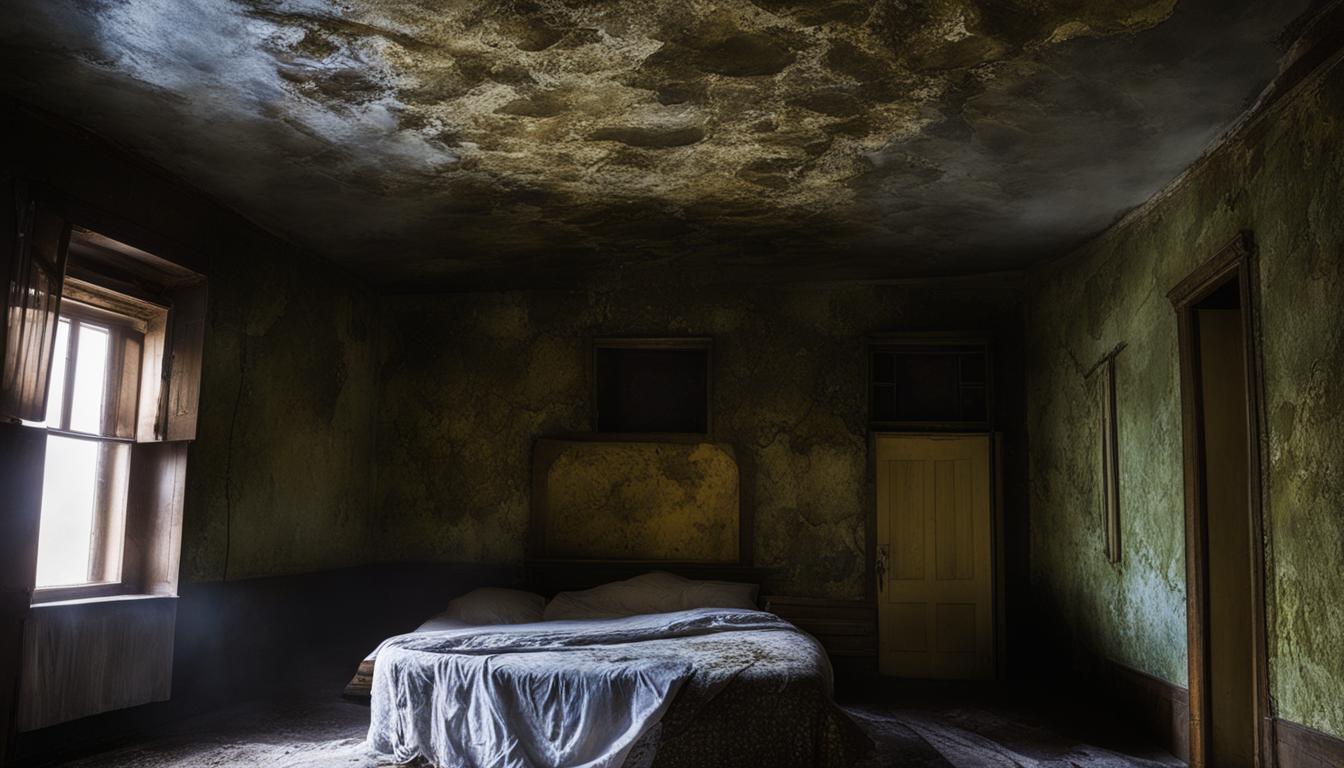Water damage can occur in any home, causing damage to the property and posing potential health hazards to its occupants. If your house has suffered water damage, you may be asking yourself: Is it safe to sleep in the house with water damage?
The answer is not straightforward. Water damage can lead to various safety concerns and health risks that should not be overlooked. In this section, we will explore whether it is safe to sleep in a house with water damage. We will discuss the potential health risks and safety concerns associated with staying in such an environment, and provide practical steps to ensure you and your family’s safety.
Key Takeaways
- Water damage can pose significant health and safety risks
- Mold growth, bacteria, and pathogens can cause respiratory issues, allergies, and asthma symptoms
- Water damage can lead to structural issues, electrical hazards, and slip and fall risks
- To ensure safety, seek professional inspection, ensure proper ventilation, and consider temporary housing if necessary
- Remediation and restoration are crucial in creating a safe living environment after water damage
Understanding Water Damage and Its Impact on Health
Water damage can have a significant impact on your health. When water invades your home, it creates a favorable environment for mold growth, bacteria, and pathogens to thrive. Exposure to these elements can trigger various health problems, ranging from minor allergic reactions to severe respiratory issues.
Mold growth is a common consequence of water damage. Mold spores can cause allergic reactions and respiratory issues when inhaled, especially in individuals with pre-existing conditions such as asthma and allergies. Bacteria and pathogens can also thrive in water-damaged environments, increasing the risk of infections and illnesses.
According to the Centers for Disease Control and Prevention (CDC), exposure to damp and moldy environments is associated with various health effects, including nasal stuffiness, eye irritation, skin irritation, and wheezing. Prolonged exposure can also lead to more severe respiratory issues such as severe asthma and lung infections.
It is essential to address water damage promptly to mitigate these health risks. When water damage occurs, it is crucial to dry the affected area immediately to prevent mold growth and bacterial proliferation. In more severe cases, professional water damage restoration services may be necessary to ensure complete remediation.
Health Risks of Mold Exposure in Water-Damaged Homes
If you are exposed to mold in a water-damaged home, it can have adverse effects on your respiratory health. Mold spores can cause a range of symptoms, including coughing, wheezing, and shortness of breath. For individuals with preexisting respiratory issues, such as asthma, mold exposure can make symptoms worse, leading to increased hospitalizations and emergency room visits.
Mold can also trigger allergies, causing symptoms such as sneezing, runny nose, and itchy eyes. With prolonged exposure, individuals may develop hypersensitivity pneumonitis, an inflammatory lung disease that can be debilitating.
To protect your health, it is crucial to address mold exposure promptly. You should seek professional assistance to assess the extent of mold growth and develop a remediation plan. To prevent mold growth, ensure proper ventilation in your home, particularly in damp areas. You can also use dehumidifiers to reduce excess moisture and prevent mold from growing.
| Symptoms of Mold Exposure | Symptoms of Respiratory Issues | |
|---|---|---|
| 1 | Coughing | Coughing |
| 2 | Shortness of breath | Shortness of breath |
| 3 | Wheezing | Wheezing |
| 4 | Sneezing | Nasal congestion |
| 5 | Runny nose | Chest pain |
Table: Comparing Symptoms of Mold Exposure with Allergies
| Symptoms of Mold Exposure | Symptoms of Allergies | |
|---|---|---|
| 1 | Coughing | Coughing |
| 2 | Shortness of breath | Sneezing |
| 3 | Wheezing | Runny nose |
| 4 | Sneezing | Itchy eyes |
| 5 | Runny nose | Skin rash |
Safety Concerns in Water-Damaged Homes
Water damage can pose significant safety risks in a home. Structural damage is one of the most concerning issues, and it can be difficult to detect without professional assessment. Over time, water can weaken structures such as walls, ceilings, and floors, increasing the risk of collapse. Additionally, electrical hazards may arise from water damage, leading to an increased risk of electrocution or fire. It’s important to prioritize electrical safety during remediation and restoration processes.
Slip and fall risks are also prevalent in water-damaged homes. The presence of water and dampness can create a hazardous environment, particularly on smooth surfaces such as tiles or hardwood floors. It’s crucial to address any standing water or moisture in the home to prevent the risk of accidents.
| Structural Component | Effect of Water Damage |
|---|---|
| Foundation | Cracks, settling, weakening of support structures |
| Walls | Bowing, warping, cracks, weakened load-bearing capacity |
| Ceiling | Sagging, weakening of support structures |
| Floors | Warped, damaged subflooring, weakened load-bearing capacity |
If you suspect structural damage or electrical hazards in your home, it’s crucial to seek professional assistance. This will help ensure your safety and prevent further damage to your property. In summary, do not underestimate the safety risks posed by water damage, and address them promptly and professionally to protect you and your loved ones.
Steps to Ensure Safety When Sleeping in a Water-Damaged Home
If you must sleep in a water-damaged home, taking safety precautions can help protect your health and wellbeing. Below are practical steps you can take to safeguard yourself:
- Seek professional inspection: A professional inspection can help assess the extent of water damage and identify potential safety hazards.
- Ensure proper ventilation: Proper ventilation can help prevent the growth of mold and bacteria. Keep windows open, use fans and dehumidifiers to promote air flow.
- Consider temporary housing: If the water damage is extensive or poses significant health risks, consider staying in temporary housing until the issue is resolved.
Additionally, be cautious when navigating through water-damaged areas of the home. Wear proper footwear to protect against slip and fall risks. Avoid contact with standing water and don’t touch any electrical appliances or outlets that may have been impacted by the water damage.
By taking these safety precautions, you can minimize your risk of exposure to harmful contaminants, ensuring a safer sleeping environment.
Remediation and Restoration: Restoring Safety in a Water-Damaged Home
If you’ve experienced water damage in your home, it’s crucial to address it promptly to avoid potential health risks and safety hazards. Remediation and restoration services can help restore safety in your water-damaged home.
A professional water damage restoration service can assess the extent of the damage and provide a comprehensive plan for restoring your home. This includes a thorough drying process to prevent the growth of mold and bacteria, as well as mold removal if necessary.
It’s important to understand that water damage restoration is not a DIY project. Without access to professional-grade equipment and expertise, you may inadvertently create additional safety hazards or exacerbate the existing damage. Professional services are vital to ensure the safety of your living environment.
The drying process is a critical aspect of water damage restoration. It involves using specialized equipment like dehumidifiers and air movers to remove moisture from the air and surfaces in your home. This prevents the growth of mold and bacteria that can pose serious health risks.
Mold removal is also an essential part of water damage restoration. Mold can spread rapidly and produce harmful toxins that can cause respiratory issues and other health problems. A professional remediation service can safely and effectively remove any mold present in your home, ensuring the safety of your living environment.
Overall, remediation and restoration services are crucial for restoring safety in a water-damaged home. If you’ve experienced water damage in your home, seek professional services immediately to ensure a safe living environment.
Conclusion
You should never compromise your health or safety by sleeping in a water-damaged home. As we’ve seen, exposure to mold, bacteria, and structural hazards can lead to severe health issues, including respiratory problems, allergies, and asthma.
It is crucial to take appropriate safety precautions to protect yourself and your loved ones. Seek professional assistance, invest in proper ventilation, and consider temporary housing if necessary.
Remember, water damage restoration is key to restoring safety in your home. Professional services can help you with the drying process, mold removal, and other remediation techniques to ensure a safe living environment.
Don’t take any chances with your health and safety. Take action today and ensure that you and your family can sleep soundly in a safe and healthy home.
FAQ
Is it safe to sleep in a house with water damage?
No, sleeping in a water-damaged home is not safe. It can pose significant health risks and safety concerns.
What are the potential health risks of staying in a water-damaged environment?
Exposing yourself to a water-damaged environment can lead to various health risks, including mold growth, the presence of bacteria, and the spread of pathogens.
How does mold exposure in water-damaged homes affect health?
Mold exposure in water-damaged homes can cause respiratory issues, trigger allergies, and worsen asthma symptoms.
What safety concerns arise in water-damaged homes?
Water-damaged homes may have structural damage, electrical hazards, and increased risks of slips and falls, compromising overall safety.
What steps can I take to ensure safety when sleeping in a water-damaged home?
To ensure safety when sleeping in a water-damaged home, it is important to take safety precautions, seek a professional inspection, ensure proper ventilation, and consider temporary housing if necessary.
Why is remediation and restoration important in a water-damaged home?
Remediation and restoration play a crucial role in restoring safety in a water-damaged home. Professional services, the drying process, and mold removal help create a safe living environment.






















